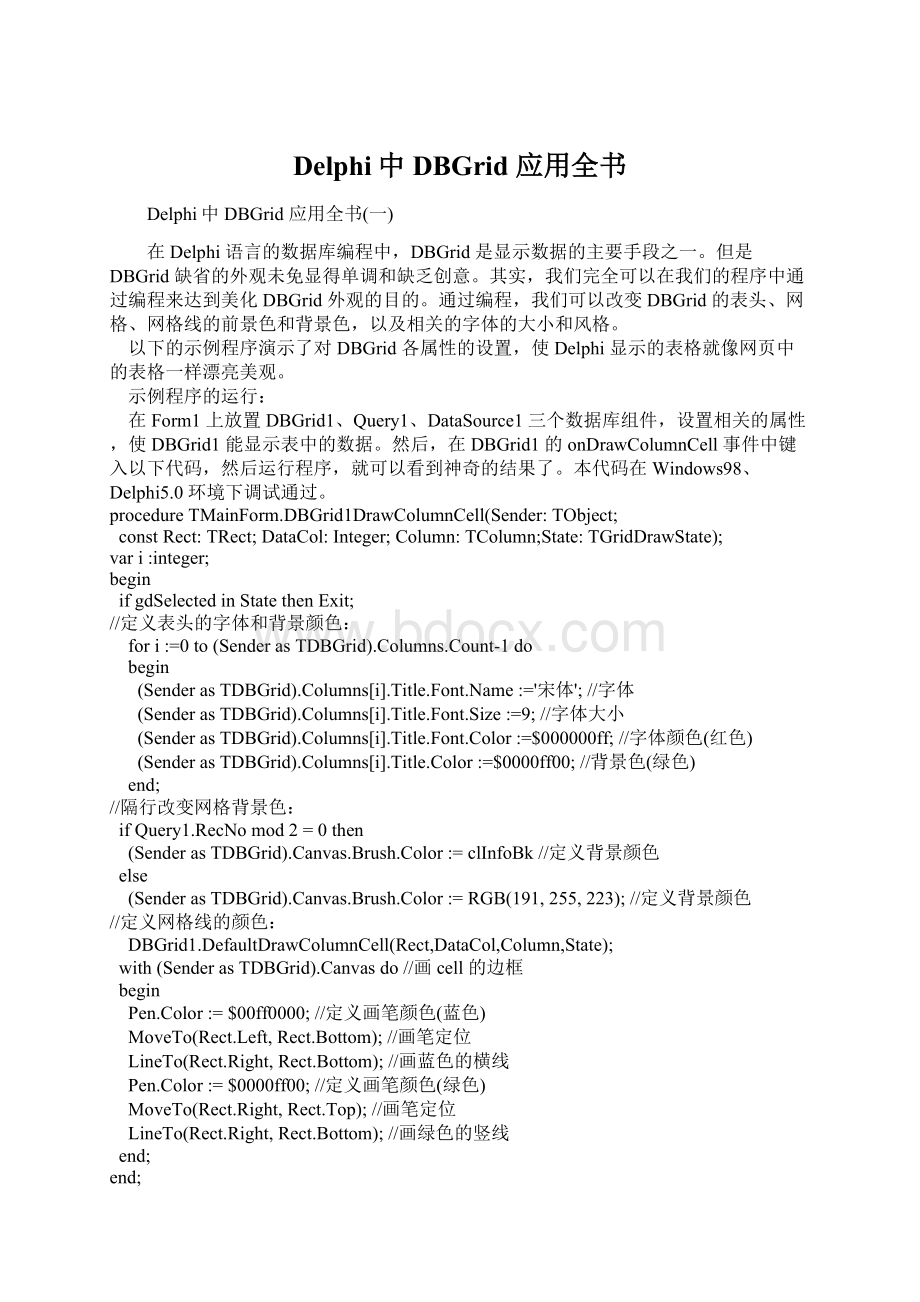Delphi中DBGrid 应用全书.docx
《Delphi中DBGrid 应用全书.docx》由会员分享,可在线阅读,更多相关《Delphi中DBGrid 应用全书.docx(19页珍藏版)》请在冰豆网上搜索。

Delphi中DBGrid应用全书
Delphi中DBGrid应用全书
(一)
在Delphi语言的数据库编程中,DBGrid是显示数据的主要手段之一。
但是DBGrid缺省的外观未免显得单调和缺乏创意。
其实,我们完全可以在我们的程序中通过编程来达到美化DBGrid外观的目的。
通过编程,我们可以改变DBGrid的表头、网格、网格线的前景色和背景色,以及相关的字体的大小和风格。
以下的示例程序演示了对DBGrid各属性的设置,使Delphi显示的表格就像网页中的表格一样漂亮美观。
示例程序的运行:
在Form1上放置DBGrid1、Query1、DataSource1三个数据库组件,设置相关的属性,使DBGrid1能显示表中的数据。
然后,在DBGrid1的onDrawColumnCell事件中键入以下代码,然后运行程序,就可以看到神奇的结果了。
本代码在Windows98、Delphi5.0环境下调试通过。
procedureTMainForm.DBGrid1DrawColumnCell(Sender:
TObject;
constRect:
TRect;DataCol:
Integer;Column:
TColumn;State:
TGridDrawState);
vari:
integer;
begin
ifgdSelectedinStatethenExit;
//定义表头的字体和背景颜色:
fori:
=0to(SenderasTDBGrid).Columns.Count-1do
begin
(SenderasTDBGrid).Columns[i].Title.Font.Name:
='宋体';//字体
(SenderasTDBGrid).Columns[i].Title.Font.Size:
=9;//字体大小
(SenderasTDBGrid).Columns[i].Title.Font.Color:
=$000000ff;//字体颜色(红色)
(SenderasTDBGrid).Columns[i].Title.Color:
=$0000ff00;//背景色(绿色)
end;
//隔行改变网格背景色:
ifQuery1.RecNomod2=0then
(SenderasTDBGrid).Canvas.Brush.Color:
=clInfoBk//定义背景颜色
else
(SenderasTDBGrid).Canvas.Brush.Color:
=RGB(191,255,223);//定义背景颜色
//定义网格线的颜色:
DBGrid1.DefaultDrawColumnCell(Rect,DataCol,Column,State);
with(SenderasTDBGrid).Canvasdo//画cell的边框
begin
Pen.Color:
=$00ff0000;//定义画笔颜色(蓝色)
MoveTo(Rect.Left,Rect.Bottom);//画笔定位
LineTo(Rect.Right,Rect.Bottom);//画蓝色的横线
Pen.Color:
=$0000ff00;//定义画笔颜色(绿色)
MoveTo(Rect.Right,Rect.Top);//画笔定位
LineTo(Rect.Right,Rect.Bottom);//画绿色的竖线
end;
end;
2.Delphi5-隔行改变DBGrid网格颜色:
在Form1上放置DBGrid1、Query1、DataSource1三个数据库组件,设置相关的属性,使DBGrid1能显示表中的数据。
然后,在DBGrid1的onDrawColumnCell事件中键入以下代码,然后运行程序
procedureTForm1.DBGrid1DrawColumnCell(Sender:
TObject;constRect:
TRect;
DataCol:
Integer;Column:
TColumn;State:
TGridDrawState);
vari:
integer;
begin
ifgdSelectedinStatethenExit; //隔行改变网格背景色:
ifadoQuery1.RecNomod2=0then
(SenderasTDBGrid).Canvas.Brush.Color:
=clinfobk//定义背景颜色
else
(SenderasTDBGrid).Canvas.Brush.Color:
=RGB(191,255,223); //定义背景颜色
//定义网格线的颜色:
DBGrid1.DefaultDrawColumnCell(Rect,DataCol,Column,State);
with(SenderasTDBGrid).Canvasdo//画cell的边框
begin
Pen.Color:
=$00ff0000;//定义画笔颜色(蓝色)
MoveTo(Rect.Left,Rect.Bottom);//画笔定位
LineTo(Rect.Right,Rect.Bottom);//画蓝色的横线
Pen.Color:
=clbtnface;//定义画笔颜色(兰色)
MoveTo(Rect.Right,Rect.Top);//画笔定位
LineTo(Rect.Right,Rect.Bottom);//画绿色
end;
end;
3.DBGrid指定列上显示DBComboBox
设置DBGrid1的OnDrawDataCell事件如下:
procedureTForm1.DBGrid1DrawDataCell(Sender:
TObject;constRect:
TRect;Field:
TField;State:
TGridDrawState);
begin
if(gdFocusedinState)then
begin
if(Field.FieldName=DBComboBox1.DataField)then
begin
DBComboBox1.Left:
=Rect.Left+DBGrid1.Left;
DBComboBox1.Top:
=Rect.Top+DBGrid1.top;
DBComboBox1.Width:
=Rect.Right-Rect.Left;
DBComboBox1.Height:
=Rect.Bottom-Rect.Top;
DBComboBox1.Visible:
=True;
end;
end;
end;
2)、DBGrid指定单元格未获得焦点时不显示DBComboBox,设置DBGrid1的OnColExit事件如下:
procedureTForm1.DBGrid1ColExit(Sender:
TObject);
begin
IfDBGrid1.SelectedField.FieldName=DBComboBox1.DataFieldthen
begin
DBComboBox1.Visible:
=false;
end;
end;
3)、当DBGrid指定列获得焦点时DrawDataCell事件只是绘制单元格,并显示DBComboBox,但是DBComboBox并没有获得焦点,数据的输入还是在单元格上进行。
在DBGrid1的KeyPress事件中调用SendMessage这个WindowsAPI函数将数据输入传输到DBComboBox上,从而达到在DBComboBox上进行数据输入。
因此还要设置KeyPress事件如下:
procedureTForm1.DBGrid1KeyPress(Sender:
TObject;varKey:
Char);
begin
if(key<>chr(9))then
begin
if(DBGrid1.SelectedField.FieldName=DBComboBox1.DataField)then
begin
DBComboBox1.SetFocus;
SendMessage(DBComboBox1.Handle,WM_Char,word(Key),0);
end;
end;
end;
打印TDBGrid内容----方法1
procedurePrintDbGrid(DataSet:
TDataSet;DbGrid:
TDbGrid;Title:
String);
var
PointX,PointY:
integer;
ScreenX:
integer;
i,lx,ly:
integer;
px1,py1,px2,py2:
integer;
RowPerPage,RowPrinted:
integer;
ScaleX:
Real;
THeight:
integer;
TitleWidth:
integer;
SumWidth:
integer;
PageCount:
integer;
SpaceX,SpaceY:
integer;
RowCount:
integer;
begin
PointX:
=Round(GetDeviceCaps(printer.Handle,LOGPIXELSX)/2.54);
PointY:
=Round(GetDeviceCaps(printer.Handle,LOGPIXELSY)/2.54);
ScreenX:
=Round(Screen.PixelsPerInch/2.54);
ScaleX:
=PointX/ScreenX;
RowPrinted:
=0;
SumWidth:
=0;
printer.BeginDoc;
WithPrinter.Canvasdo
begin
DataSet.DisableControls;
DataSet.First;
THeight:
=Round(TextHeight('我')*1.5);//设定每行高度为字符高的1.5倍
SpaceY:
=Round(TextHeight('我')/4);
SpaceX:
=Round(TextWidth('我')/4);
RowPerpage:
=Round((printer.PageHeight-5*PointY)/THeight);//上下边缘各2厘米
ly:
=2*PointY;
PageCount:
=0;
whilenotDataSet.Eofdo
begin
if(RowPrinted=RowPerPage)or(RowPrinted=0)then
begin
ifRowPrinted<>0then
Printer.NewPage;
RowPrinted:
=0;
PageCount:
=PageCount+1;
Font.Name:
='宋体';
Font.size:
=16;
Font.Style:
=Font.Style+[fsBold];
lx:
=Round((Printer.PageWidth-TextWidth(Title))/2);
ly:
=2*PointY;
TextOut(lx,ly,Title);
Font.Size:
=11;
Font.Style:
=Font.Style-[fsBold];
lx:
=Printer.PageWidth-5*PointX;
ly:
=Round(2*PointY+0.2*PointY);
ifRowPerPage*PageCount>DataSet.RecordCountthen
RowCount:
=DataSet.RecordCount
else
RowCount:
=RowPerPage*PageCount;
TextOut(lx,ly,'第'+IntToStr(RowPerPage*(PageCount-1)+1)+'-'+IntToStr(RowCount)+'条,共'+IntToStr(DataSet.RecordCount)+'条');
lx:
=2*PointX;
ly:
=ly+THeight*2;
py1:
=ly-SpaceY;
ifRowCount=DataSet.RecordCountthen
py2:
=py1+THeight*(RowCount-RowPerPage*(PageCount-1)+1)
else
py2:
=py1+THeight*(RowPerPage+1);
SumWidth:
=lx;
fori:
=0toDBGrid.Columns.Count-1do
begin
px1:
=SumWidth-SpaceX;
px2:
=SumWidth;
MoveTo(px1,py1);
LineTo(px2,py2);
TitleWidth:
=TextWidth(DBGrid.Columns[i].Title.Caption);
lx:
=Round(SumWidth+(DBGrid.Columns[i].width*scaleX-titleWidth)/2);
TextOut(lx,ly,DBGrid.Columns[i].Title.Caption);
SumWidth:
=Round(SumWidth+DBGrid.Columns[i].width*scaleX)+SpaceX*2;
end;
px1:
=SumWidth; //画最后一条竖线
px2:
=SumWidth;
MoveTo(px1,py1);
LineTo(px2,py2);
px1:
=2*PointX; //画第一条横线
px2:
=SumWidth;
py1:
=ly-SpaceY;
py2:
=ly-SpaceY;
MoveTo(px1,py1);
LineTo(px2,py2);
py1:
=py1+THeight;
py2:
=py2+THeight;
MoveTo(px1,py1);
LineTo(px2,py2);
end;
lx:
=2*PointX;
ly:
=ly+THeight;
px1:
=lx;
px2:
=SumWidth;
py1:
=ly-SpaceY+THeight;
py2:
=ly-SpaceY+THeight;
MoveTo(px1,py1);
LineTo(px2,py2);
fori:
=0toDBGrid.Columns.Count-1do
begin
TextOut(lx,ly,DataSet.FieldByname(DBGrid.Columns[i].Fieldname).AsString);
lx:
=Round(lx+DBGrid.Columns[i].width*ScaleX+SpaceX*2);
end;
RowPrinted:
=RowPrinted+1;
DataSet.next;
end;
DataSet.first;
DataSet.EnableControls;
end;
printer.EndDoc;
end;
把DBGrid输出到Excel表格---方法一
(支持多Sheet){
功能描述:
把DBGrid输出到Excel表格(支持多Sheet)
调用格式:
CopyDbDataToExcel([DBGrid1,DBGrid2]);
}
procedureCopyDbDataToExcel(Args:
arrayofconst);
var
iCount,jCount:
Integer;
XLApp:
Variant;
Sheet:
Variant;
I:
Integer;
begin
Screen.Cursor:
=crHourGlass;
ifnotVarIsEmpty(XLApp)then
begin
XLApp.DisplayAlerts:
=False;
XLApp.Quit;
VarClear(XLApp);
end;
try
XLApp:
=CreateOleObject(‘Excel.Application‘);
except
Screen.Cursor:
=crDefault;
Exit;
end;
XLApp.WorkBooks.Add;
XLApp.SheetsInNewWorkbook:
=High(Args)+1;
forI:
=Low(Args)toHigh(Args)do
begin
XLApp.WorkBooks[1].WorkSheets[I+1].Name:
=TDBGrid(Args[I].VObject).Name;
Sheet:
=XLApp.Workbooks[1].WorkSheets[TDBGrid(Args[I].VObject).Name];
ifnotTDBGrid(Args[I].VObject).DataSource.DataSet.Activethen
begin
Screen.Cursor:
=crDefault;
Exit;
end;
TDBGrid(Args[I].VObject).DataSource.DataSet.first;
foriCount:
=0toTDBGrid(Args[I].VObject).Columns.Count-1do
Sheet.Cells[1,iCount+1]:
=
TDBGrid(Args[I].VObject).Columns.Items[iCount].Title.Caption;
jCount:
=1;
whilenotTDBGrid(Args[I].VObject).DataSource.DataSet.Eofdo
begin
foriCount:
=0toTDBGrid(Args[I].VObject).Columns.Count-1do
Sheet.Cells[jCount+1,iCount+1]:
=
TDBGrid(Args[I].VObject).Columns.Items[iCount].Field.AsString;
Inc(jCount);
TDBGrid(Args[I].VObject).DataSource.DataSet.Next;
end;
XlApp.Visible:
=True;
end;
Screen.Cursor:
=crDefault;
end;
dbgrid的數據導入到excel中---方法二
unitUnit1;
interface
uses
Windows,Messages,SysUtils,Classes,Graphics,Controls,Forms,Dialogs,
StdCtrls,Grids,DBGrids,Db,DBTables,Excel97,OleServer,Word97;
type
TForm1=class(TForm)
ExcelApplication1:
TExcelApplication;
ExcelWorkbook1:
TExcelWorkbook;
ExcelWorksheet1:
TExcelWorksheet;
Table1:
TTable;
DataSource1:
TDataSource;
DBGrid1:
TDBGrid;
Button1:
TButton;
Button4:
TButton;
WordApplication1:
TWordApplication;
WordDocument1:
TWordDocument;
procedureButton1Click(Sender:
TObject);
procedureButton4Click(Sender:
TObject);
private
{Privatedeclarations}
public
{Publicdeclarations}
end;
var
Form1:
TForm1;
implementation
{$R*.DFM}
procedureTForm1.Button1Click(Sender:
TObject);
var
i,row,column:
integer;
begin
Try
ExcelApplication1.Connect;
Except
MessageDlg('Excelmaynotbeinstalled',
mtError,[mbOk],0);
Abort;
End;
ExcelAp